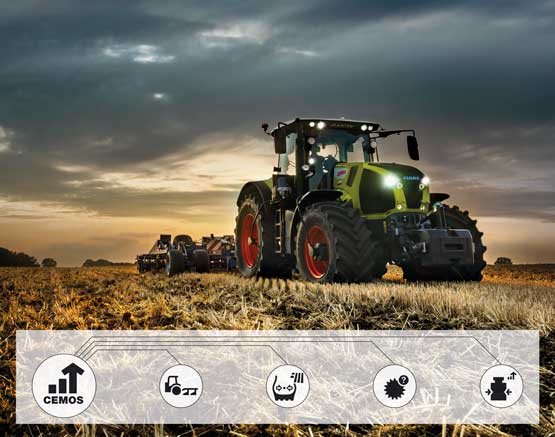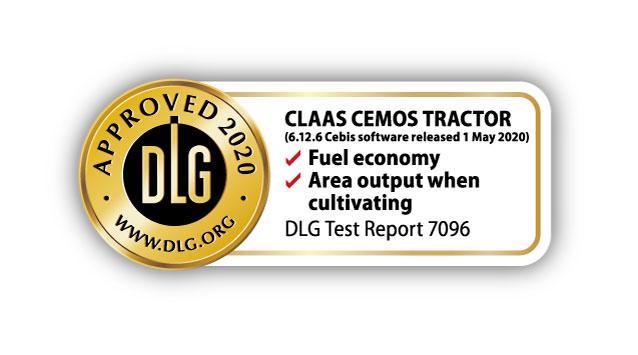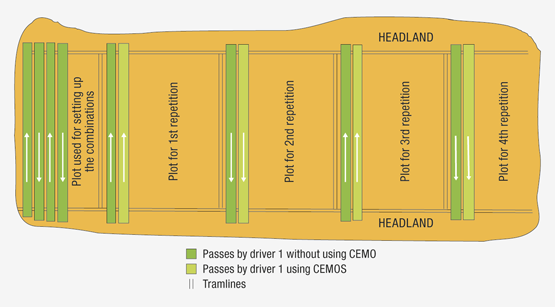CEMOS TRAKTOR - Softwareversion: 6.12.6 Cebis
DLG-APPROVED: "Driver assistance systems – fuel consumption and ha/hr performance in cultivation"
The quality mark
A test mark „DLG-APPROVED for individual criteria“ is awarded for agricultural products which have successfully fulfilled a scope-reduced usability testing conducted by DLG according to independent and recognised evaluation criteria. The test is intended to highlight particular innovations and key criteria of the test object. The test may contain criteria from the DLG test scope for overall tests, or focus on other value-determining characteristics and properties of the test subject. The minimum requirements, test conditions and procedures as well as the evaluation bases of the test results will be specified in consultation with an expert group of DLG. They correspond to the recognised rules of technology, as well as scientific and agricultural knowledge and requirements. The successful testing is concluded with the publication of a test report, as well as the awarding of the test mark which is valid for five years from the date of awarding.
The CLAAS CEMOS TRACTOR driver assistance system (6.12.6 software version released 1 May 2020) installed on a CLAAS Axion 870 was submitted to the DLG Partial Test ‘Driver assistance systems – fuel consumption and ha/hr performance in cultivation’. The tests were carried out in September 2020 and consisted of using the system in shallow and deep cultivation, measuring the impact of the system on specific fuel consumption during cultivation (l/ha), on the ha/hr performance and the quality of work. No further criteria came to the test.
Assessment in brief
This DLG test compared the configurations of the tractor cultivator combination and their individual effects on the cultivation results – both in shallow and deep work. The comparison involved two test variants – one in which the combination was configured manually and one in which the operator was assisted by CLAAS CEMOS. The test focused on determining the impact of the system on specific fuel consumption (l/ha), ha/hr performance and quality of work. The testers were 10 drivers who were experienced in cultivating. In the first step, they were tasked to manually
set up the combination to two specific depths and then cultivate specific test courses. After that, the settings were altered in line with the suggestions made by CLAAS CEMOS. Then the same operator cultivated further test courses adjacent to the passes cultivated in the previous ‘manual’ runs. The test runs that focused on fuel efficiency showed that none of the 10 drivers managed to work more fuel-efficiently with a manually configured combination than when using the CLAAS CEMOS assistance system. Fuel efficiency increased for 9 of the 10 drivers. Averaging the fuel consumption of all 10 operators showed a drop by 6%. The savings potential was up to 16.8%.
In the ha/hr performance category, 8 out of 10 operators were able to increase the ha/hr performance in cultivation by using the CLAAS CEMOS assistance system. By averaging the results of all 10 drivers, the test engineers found that area output increased by 5.6% over unassisted cultivation. The savings potential was up to 16.3%.
After completing all test runs, each driver assessed the quality of work of the cultivated passes, comparing the results of assisted and unassisted configurations. The following criteria were applied for assessing the quality of work: straw mat, the levelling and tillage effects and the effectiveness of straw incorporation. The assessments were made by applying a five-point grading system: (1 = very good; 5= not sufficient).
After averaging the assessments made by all drivers, it was found that the quality of work improved scarcely or very little by using the CLAAS CEMOS assistance system (2.3 vs 2.5).
A correlation between the effects on specific fuel consumption, area output and the quality of work was not found.
The CLAAS CEMOS driver assistance systems (6.12.6 software version released 1 May 2020) meets all criteria for obtaining
the DLG APPROVED quality mark on ‘driver assistance systems – fuel consumption and ha/hr performance in cultivation’.
The Product
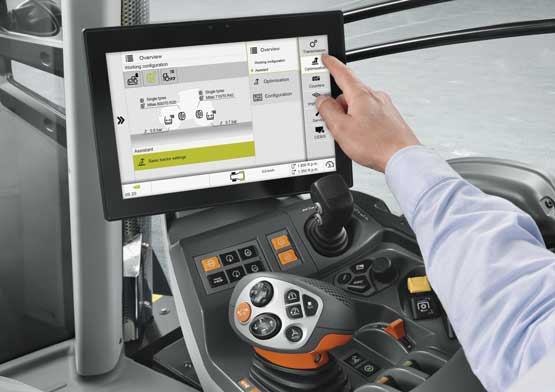
CEBIS operator terminal
Description and technical data
CLAAS CEMOS TRACTOR is a driver assistance feature that is integrated in the CEBIS operator terminal and is available for all CLAAS ARION and AXION tractors. As a first step, the system asks the operator to enter various parameters including soil moisture and soil type, working depth and implement data. The specific tyres fitted are also logged to the software. The system uses the information to compute suggestions on the proper ballast weight in the front linkage, rear linkage or on the wheels. After that, the operator enters the actual ballast weight. Any disparity between actual ballasting and the suggested weight (for example the absence of a specific front weight) is taken into account by the system as it guides the operator through the optimising dialogue and computes the ideal tyre pressure. This optimising dialogue can be carried out on the move and at any time. CEMOS for tractors also helps operators increase the efficiency of the combination, aiming at maximising either ha/hr performance or fuel efficiency. Either way, the system ascertains the current set-up in a first step and then takes the operator through a serious of various suggestions on optimising acreage or fuel efficiency. The outcome of the changes – whether
positive or negative – is displayed immediately for the operator to confirm the new settings or resume the previous settings.
The Method
Die The DLG test on assistance systems explores the impact a driver assistance system has on fuel consumption and power input, ha/hr performance and quality of work in comparison with unassisted set-ups.
The test can be carried out with tractors, tractor-implement combinations and self-propelled machines. It covers all major tasks that are typically carried out by a tractor, a combination or self-propelled machine. The test follows specific testing schemes and routines. A test of a tractor-cultivator combination focuses on the impact the assistance system has on specific fuel consumption, ha/hr performance and quality of work in shallow and deep cultivation.
All test runs are carried out in a sufficiently large field with minimum variations in terms of conditions and with a uniform stubble and straw mat. The assisted/unassisted cultivation passes are adjacent to each other (figure 3). The tramlines are not used and serve to split the test field into the individual test plots. The working depths are defined prior to the test and then maintained throughout the runs.
The drivers who are eligible to drive the tractor cultivator combinations must be familiar with cultivating and must not be using the tested assistance system at their own businesses.
The first set of tests involves cultivating four passes without using the assistance system. For this, each operator configures the combination manually to a specific depth and in line with field conditions. The setting options include the following:
- ballast weight
- tyre pressure
- engine load limit
- forward speed
- four-wheel drive and diff lock activation
- lower link position
- gearbox acceleration rate
Then, the same operator carries out a second series of tests, this time assisted by CEMOS. This means he/she alters the settings as suggested by the system. This can be done manually according to the system prompts, automatically or semi automatically. What is not changed is the working depth which is verified at regular intervals.
Fuel consumption and forward speed are measured during the test runs and used to compute the specific fuel consumption (l/ha) and ha/hr performance for each specific test run.
After all test runs are completed, the quality of work of each individual pass is inspected visually by the test drivers who assess it to a 5-point grading system (1 = very good, 5 = not sufficient). This assessment is based on the following criteria: straw mat, surface levelling, tilling effect and straw incorporation.
Further on, the test conditions are documented by describing the test fields and recording the weather conditions.
The DLG quality mark is awarded on the condition that
a) the average fuel consumption rate decreases by at least 5% without affecting the area output and quality of work
or
b) the area output increases by an average of 5% without negatively impacting the specific fuel consumption and the quality of work.
The quality of work is considered to have increased significantly, if the use of the assistance system makes a difference of more than 0.5 points in the average score.
Detailed account of the test results
Detailed account of the test results
The test runs took place in two fields after wheat in Saxony-Anhalt, Germany, in September 2020. Table 2 shows the field conditions and the history of the largely homogeneous plots.
Table 2: Quality and history of both test fields
|
Field no. 1 deep cultivation |
Field no. 2 shallow cultivation | |
|---|---|---|
| Soil value number | 51 | 84 |
| Soil type | light loamy sand | heavy loamy sand |
| Previous crop | winter wheat | winter wheat |
| Harvest date | 18/19 July 2020 (straw chopped) | 22 July 202 (straw chopped) |
| Preceding work | stubble incorporation using a kelle chain harrow | no post-harvest measures |
| Working depth during the DLG test | approx. 23cm | approx. 14cm |
| Soil moisture | 8.5% | 14.6% |
The weather was sunny with light winds and the temperatures were between 14° C and 34° C during all three days of the test period.
Tractors and cultivators used
The tractors were two CLAAS AXION 870 tractors of identical build and powered by a 221kW/300hp engine (rated output at 1,800rpm to ECE R 120). One tractor had 800kg wheel weights which the other tractor didn’t have. The fact that the two tractors were of identical build with only one being fitted with wheel weights allowed operators to choose between wheel weights and no wheels weights without bothering about a time-consuming conversion. The choice of front weights comprised 900kg, 1200kg, 1500kg and 1800kg units.
The test operators
Our test drivers were ten farmers who were all very experienced in cultivating and who were familiar with the tractor. Yet none of them had yet used the CLAAS CEMOS assistance system on their farms. All shared the same management approach which focused on saving inputs such as fuel. Hence, all operators were very motivated to take part in the test and all were experts in setting up a combination with a focus on optimum fuel efficiency. The drivers came from Germany, France, Denmark and Poland.
Fuel economy
Compared with the manual set-ups, 9 out of 10 drivers were able to reduce fuel consumption when using the CLAAS CEMOS assistance system in cultivation. The average saving rate across all 10 operators was 8%. This saving effect was far more pronounced in deep cultivation than in shallow work. In deep work, the assistance system led to fuel savings of 2.4% to 16.8%. Only one test driver achieved no savings in shallow work despite using the assistance system. This particular operator had chosen more or less the same manual settings as the ones suggested by assistance system in the second test variant.
The comparison of fuel consumption shows that the use of the driver assistance system led to a reduction in specific fuel consumption of up to 16.8% which translates into 2.6 litres per hectare.
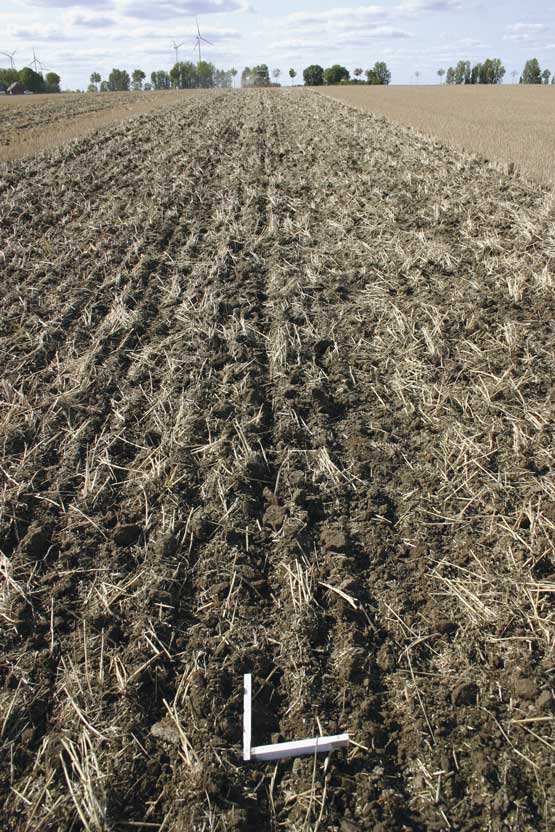
Ha/hr performance
Aiming at operating as fuel-efficiently as possible, 8 out of 10 test drivers were able to increase their work rates in cultivation by using the CLAAS CEMOS assistance system. In two cases, the assistance system suggested a lower forward speed than what had been selected by the test drivers. This led to a reduction in both ha/hr performance and fuel consumption. With the results all 10 testers averaged, the assistance system proved to increase the area output by 5.6% over the test runs without the assistance system. When assessing the performance of each individual operator, the maximum increase was 16.3%, which was achieved by increasing forward speed from 6.8km/h to 7.9km/h as suggested by the assistance system. The CLAAS CEMOS assistance system had a clearly more positive effect on the work rate in the deep cultivation passes where acreage increased between 3.2% and 16.3% as compared with the shallow work where the increase was between 1.3% and 3.2%.
Quality of work
After completing all test runs, each driver assessed the quality of work in all cultivated passes, comparing the results that were achieved by adopting CLAAS CEMOS suggestions with those achieved when not using the assistance system. The criteria for assessing the quality of work were the straw mat, the levelling effect, tillage and straw incorporation. To make their assessments, the drivers used a five-point grading system from (1 = very good; 5= not sufficient). The average quality of work was slightly better when using the CLAAS CEMOS assistance system (2.3 vs 2.5). Six test drivers said the quality of work achieved by using the assistance system in comparison with the quality of unassisted setup was equal or only slightly different (scoring a difference of less than or equal to 0.5). Three of the 10 test drivers said the quality of work in conjunction with the CLAAS CEMOS assistance system was clearly better than when setting up the combination manually. One test driver said it was clearly poorer (resulting in a grade difference of more than 0.5). A correlation between the impact of specific fuel consumption, acreage and quality of work assessment was not found.
Table 3: Fuel consumption, ha/hr performance and quality of work
|
Spec. fuel consumption without CEMOS / with CEMOS [l/ha] |
Fuel savings using CEMOS [%] |
ha/hr increase [%] |
Quality of work assessment* without CEMOS / with CEMOS | |
|---|---|---|---|---|
| shallow work | 8,2 / 8,0 | 2,8 | 1,0 | 2,4 / 2,7 |
| deep work | 14,0 / 12,9 | 7,3 | 7,6 | 2,5 / 2,1 |
| total | 12,3 / 11,5 | 6,0 | 5,6 | 2,5 / 2,3 |
* very good (1), good (2), satisfactory (3), sufficient (4), not sufficient (5)
Summary
This DLG test compared cultivation results in shallow and deep work that were achieved by unassisted and assisted tractor cultivator configurations. The test focused on exploring the impact of the CLAAS CEMOS system on specific fuel consumption (l/ha), ha/hr performance and quality of work.
Compared with manual set-ups, the use of the CLAAS CEMOS assistance system in cultivation led to a reduction of fuel in 9 from 10 test runs. On average, the fuel savings achieved by all 10 operators were 6%. The savings potential was up to 16.8%.
By using the CLAAS CEMOS assistance system, 8 out of 10 operators were able to increase the ha/hr performance of the tractor cultivator combination. The averaged result of all 10 drivers shows a 5.6% increase over unassisted cultivation. The savings potential was up to 16.3%.
After the test runs the drivers assessed the quality of work using a five-point grading system: (1 = very good; 5= not sufficient). No relevant difference was found between the quality of work achieved by assisted set-up (2.3 score) and unassisted set-up (2.5 score).
Based on the above results, the CLAAS CEMOS driver assistance systems (6.12.6 software version released 1 May 2020) is awarded the DLG APPRO-VED quality mark on the criterion ‘driver assistance systems – fuel consumption and ha/hr performance when cultivation’.
Kontakt
DLG-Testzentrum Technik und Betriebsmittel • DLG TestService GmbH Standort Groß-Umstadt • Max-Eyth-Weg 1 • 64823 Groß-Umstadt • Tel: +49(0)69/24 788-600 Fax: +49(0)69/24 788-690 • tech@DLG.org

